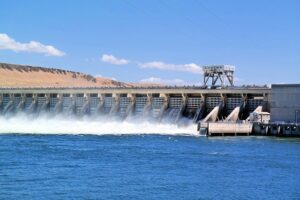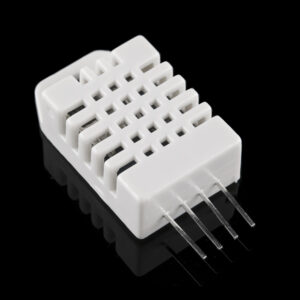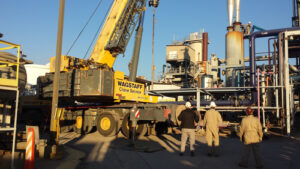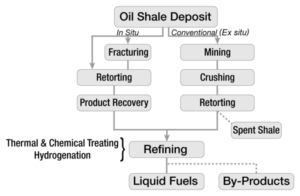 Temperature is a key safety indicator in any industry. The technology of distributed temperature sensors using optical fiber allows measuring the temperature at any point in the fiber, with an interval of 1 meter, resulting in the detailed temperature dependence of all required areas. The data obtained by this technique makes it possible to develop intelligent warning systems based on it, therefore, replacing outdated point-based monitoring systems.
Temperature is a key safety indicator in any industry. The technology of distributed temperature sensors using optical fiber allows measuring the temperature at any point in the fiber, with an interval of 1 meter, resulting in the detailed temperature dependence of all required areas. The data obtained by this technique makes it possible to develop intelligent warning systems based on it, therefore, replacing outdated point-based monitoring systems.
Operating principle of temperature sensors
The optical fiber itself acts like a fiber optic sensor, and the distributed nature of the DTS technology enables us to determine the temperature change at an arbitrary point, spreading many kilometers from it. Moreover, the measurement quality is not affected by electromagnetic radiation, thus, the distributed temperature technology is free from false alarms.
To be more precise, distributed temperature sensors (DTS) allow measuring the characteristics of an object along a fiber optic cable, while the fiber cable is a linear sensor, which is a continuously distributed sensing element throughout its entire length.
The operating principle is based on the reflectivity of stimulated Raman scattering of light (Raman effect). A semiconductor laser is also used to determine the location of temperature changes in a fiber optic cable. The fact is that the structure of the optical fiber changes when the temperature changes.
When laser beam light from the laser system enters the area of temperature change, it interacts with the changed structure of the optical fiber, and in addition to direct light scattering, reflected light appears.
Benefits of temperature sensing systems
The main advantages of fiber optic sensors in comparison with classical analogs are the following:
- Compact size;
- Very fast response to parameter changes in the environment;
- Low weight;
- Multiple parameters can be registered simultaneously by a single distributed sensor;
- Reliability;
- Very wide operating temperature range of DTS;
- Small price per unit length of the sensing system;
- High sensitivity;
- Long operating time;
- The high spatial resolution of temperature sensors;
- Resistance to chemicals and aggressive environments;
- DTS is not affected by electromagnetic disturbances;
- The sensitive part of the fiber sensor does not require connection to power lines.
The processing unit measures the propagation speed and power of both direct and reflected light and determines where the temperature changes. For instance, at a wavelength of 1550 nm, a pulsed generation mode is used with a laser power limit of 10 mW.
Types of sensors for temperature measurement
There are several types of optical fibers, each of which meets certain requirements for its properties, depending on the application due to the fact that the properties of the optical fiber can be varied over a wide range.
Physical effects on the optical fiber, such as pressure, deformation, temperature change, affect the properties of the fiber at the point of exposure and it is possible to measure the environmental parameters by measuring the change in the properties of the fiber at a given point.
In general, a fiber optic sensor consists of two concentric layers: fiber core and optical coating. The fiber optic light guide part can be protected by a layer of acrylate, plastic, reinforced sheath, etc., depending on the application of this fiber cable.
Thus, distributed fiber optic sensors are perfect for industries related to combustible and explosive materials, such as coal, oil and gas production, etc. for use in fire alarm systems of various structures.
Common applications of DTS systems
Application of distributed temperature sensors includes:
- fire alarm systems in the road, rail, or service tunnels;
- thermal monitoring of power cables and overhead transmission lines to optimize production processes;
- improving the efficiency of oil and gas wells;
- ensuring the safe working condition of industrial induction melting furnaces;
- monitoring the tightness of containers with liquefied natural gas on ships in unloading terminals;
- detection of leaks in dams;
- temperature control in chemical processes;
- leak detection in pipelines.
In addition, DTS systems combined with other tools open completely new areas of application. For example, it is possible to design a specialized device – a fire detector based on a distributed fiber optic temperature sensor.
Temperature sensors for fire detection
Detecting a fire in an industrial environment is not an easy task because of the large number of disturbing factors, many of which can be considered by detectors as carriers of fire signs. In addition, dust deposited on the DTS‘ sensitive elements makes it difficult to operate and it can disable them.
It is also necessary to take into account the possible smoldering of the deposited dust, which can also lead to false alarms. The presence of fumes and aerosols makes it impossible to operate smoke optical-electronic fire detectors. The presence of carbon monoxide will trigger gas fire detectors.
Industrial facilities and production are characterized by large volumes of premises, high ceilings, the presence of long tunnels, collectors, mines, inaccessible areas, and premises with a complex configuration and geometry. And in these conditions, it is certainly possible to protect using traditional fire alarm systems, but this involves the use of a large number of detectors, and therefore they have high costs, including installation and maintenance of alarm systems and automation.
It is difficult to select detectors for explosive zones, especially for use in underground operations and mines. Aggressive media are often present in chemical industries. There are also objects of sea and river transport, characterized by the aggressive salt fog.
Oil and gas application
The use of non-electric sensing devices, the use of fiber optic cable allows the DTS to be applied in enterprises of the oil and gas complex, mines, underground operations, chemical industries (including those with aggressive environments), and metallurgy and energy enterprises.
As for oil companies, the active development of high-viscosity oil fields, which imposes strict requirements on the production equipment, and the severe depletion of most oil and gas fields require mining organizations to conduct prospecting and exploration operations, change production technologies and control the technical condition of wells.
The main task for mining companies to increase the well’s production capacity in real-time is to track information about the processes occurring in wells and fields. Solutions based on standard temperature sensors suggest well logging using point measuring instruments, which leads to the inaccuracy of the data obtained.
The disadvantages of such sensing devices include the inability to fix the distribution of one of the most important parameters of the well – the temperature profile in real-time, as well as the need for power supply, the impact on the measurement results of external electromagnetic fields, labor and time costs required for the departure of the team and performing various operations, including the immersion of the fiber sensor element and its movement along the well, data processing, etc.
DTS as a part of a fiber optic system
The fiber optic sensing system consists of distributed temperature sensors designed to measure temperature along the borehole, and a point-to-point fiber pressure sensor. Optical fibers of a distributed temperature sensing system and pressure sensors can be structurally installed in a single fiber cable.
The fiber optic cable is resistant to mechanical damage. Additional fiber optic cable protection is not required during descent and lifting operations, but the protection of the fiber cable from mechanical damage during descent and lifting operations can be provided by the use of protective coatings.
Where to buy quality temperature sensors?
If you want to obtain a highly efficient distributed temperature sensing system, you should choose the Optromix company. Optromix is a manufacturer of innovative fiber optic products for the global market. The company provides the most technologically advanced fiber optic solutions for monitoring worldwide. Optromix is a fast-growing vendor of fiber Bragg grating (FBG) products line such as fiber Bragg grating sensors, FBG interrogators and multiplexers, distributed acoustic sensing (DAS) systems, distributed temperature sensing (DTS) systems.
Distributed temperature system provides continuous underground power lines monitoring of temperatures, detecting hot spots, delivering operational status, condition assessment, and power circuit rating data. This helps operators to optimize the transmission and distribution networks, and reduce the cost of operation and capital.
Usually, the DTS systems can detect the temperature to a spatial resolution of 1 m with precision to within ±1°C at a resolution of 0.01°C. Measurement distances of greater than 30 km can be monitored and some specialized systems can provide even tighter spatial resolutions.
The advantages of working with Optromix:
- Our DTS system has the superior quality, however, its price is one of the lowest in the market;
- Optromix is ready to develop DTS systems based on customer’s specifications.
If you are interested in DTS systems and want to learn more, please contact us at info@optromix.com
 Almost all pipelines suffer from numerous leaks during their operation, therefore, they require systems for fiber optic pipeline leak detection. Despite the fact that there are various techniques for leak detection, distributed temperature sensing systems (DTS) are considered to be an ideal option for the purpose.
Almost all pipelines suffer from numerous leaks during their operation, therefore, they require systems for fiber optic pipeline leak detection. Despite the fact that there are various techniques for leak detection, distributed temperature sensing systems (DTS) are considered to be an ideal option for the purpose.

 Dams applied for hydropower, irrigation or mining play a crucial role in human life, herewith, they evoke significant human, economic, and environmental consequences when they fail. Nevertheless,
Dams applied for hydropower, irrigation or mining play a crucial role in human life, herewith, they evoke significant human, economic, and environmental consequences when they fail. Nevertheless,  Temperature is a key safety indicator in any industry. The technology of
Temperature is a key safety indicator in any industry. The technology of  A new
A new The
The Traditional in situ observations of meteorological variables are limited by surface levels, herein, it is possible to carry out the lowest observation around just 1-m height. Therefore, observation results of both shallow fog, and the initial growth stage of thicker fog layers can be missed in this case. Nevertheless, the use of
Traditional in situ observations of meteorological variables are limited by surface levels, herein, it is possible to carry out the lowest observation around just 1-m height. Therefore, observation results of both shallow fog, and the initial growth stage of thicker fog layers can be missed in this case. Nevertheless, the use of According to a recent study, the
According to a recent study, the  Today operators in highly fractured carbonate reservoirs use running wireline gradiometric surveys as a traditional way of oil-rim movement monitoring. Nevertheless, the method is not ideal because it does not allow providing the necessary information in a manner timely enough to influence operations since the surveys are conducted just a few times a year.
Today operators in highly fractured carbonate reservoirs use running wireline gradiometric surveys as a traditional way of oil-rim movement monitoring. Nevertheless, the method is not ideal because it does not allow providing the necessary information in a manner timely enough to influence operations since the surveys are conducted just a few times a year.  The traditional methods of oil extraction become less and less productive despite growing human needs. Today the main challenge of the oil industry is the development of a new way for oil recovering from unconventional sources. The solution is the extraction of oil or kerogen shales that allow diminishing oil prices.
The traditional methods of oil extraction become less and less productive despite growing human needs. Today the main challenge of the oil industry is the development of a new way for oil recovering from unconventional sources. The solution is the extraction of oil or kerogen shales that allow diminishing oil prices.  Distributed sensing technology includes
Distributed sensing technology includes